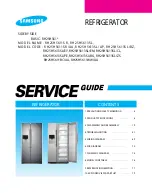
22
Temperature is too warm
■
New installation - Following installation, allow 24 hours for the refrigerator and freezer to cool
completely.
NOTE: Adjusting the temperature control(s) to the coldest setting will not cool either compartment
(refrigerator or freezer) more quickly.
■
Cooling is turned off - Turn on cooling. See “Using the Controls.”
■
Doors are opened often or not closed completely - This allows warm air to enter the refrigerator.
Minimize door openings, keep the doors fully closed, and make sure both doors are properly sealed.
■
Air vents are blocked - Remove items that are immediately in front of the vents.
■
Large amount of warm food recently added - Allow several hours for the refrigerator to return to its
normal temperature.
■
Controls are not set correctly for the surrounding conditions - Adjust the controls to a colder setting.
Check the temperature again in 24 hours.
Temperature is too cold in the
refrigerator/crisper
■
Controls are not set correctly for the surrounding conditions - Adjust the controls to a warmer setting.
Check the temperature again in 24 hours.
■
Ice storage bin is not in the correct position - See “Ice Maker and Ice Storage Bin.”
■
Air vents are blocked - Remove items that are immediately in front of the vents.
Temperature is too warm/cold
in the exterior drawer
■
Control is not set correctly for the items stored in the drawer - Adjust the temperature setting. See
“Temperature Controlled Exterior Drawer.”
Interior moisture buildup
NOTE: Some moisture buildup is normal. Clean with a soft dry cloth.
■
Room is humid - A humid environment contributes to moisture buildup. Only use the refrigerator in
an indoor location, with as little humidity as possible.
■
Doors are opened often or not closed completely - This allows humid air to enter the refrigerator.
Minimize door openings, keep the doors fully closed, and make sure both doors are properly sealed.
Frost/Ice buildup in the
freezer compartment
■
The drawer is opened often or left open - Minimize drawer openings and close drawer completely
after use.
■
Poor drawer seal - Ensure drawer seal is making full contact with the cabinet to allow for an
adequate seal.
■
Temperature control(s) are not set correctly - See “Using the Controls” for recommended
temperature settings.
DOORS AND LEVELING
Possible Causes and/or Recommended Solutions
Doors are difficult to open
■
Gaskets are dirty or sticky - Clean the gaskets and contact surfaces with mild soap and warm
water. Rinse and dry with a soft cloth.
Doors will not
close completely
■
Door is blocked open - Move food packages away from the door. Make sure all bins and shelves
are in their correct positions. Make sure all packaging materials have been removed.
Doors appear to be uneven
■
Doors need to be aligned, or refrigerator needs to be leveled - See “Refrigerator Leveling, Door
Closing and Alignment.”
GENERAL OPERATION
Possible Causes and/or Recommended Solutions
WARNING
Explosion Hazard
Use nonflammable cleaner.
Failure to do so can result in death, explosion, or fire.
Summary of Contents for 106.7300 SERIES
Page 78: ...78 NOTES ...
Page 79: ...79 NOTES ...
















































